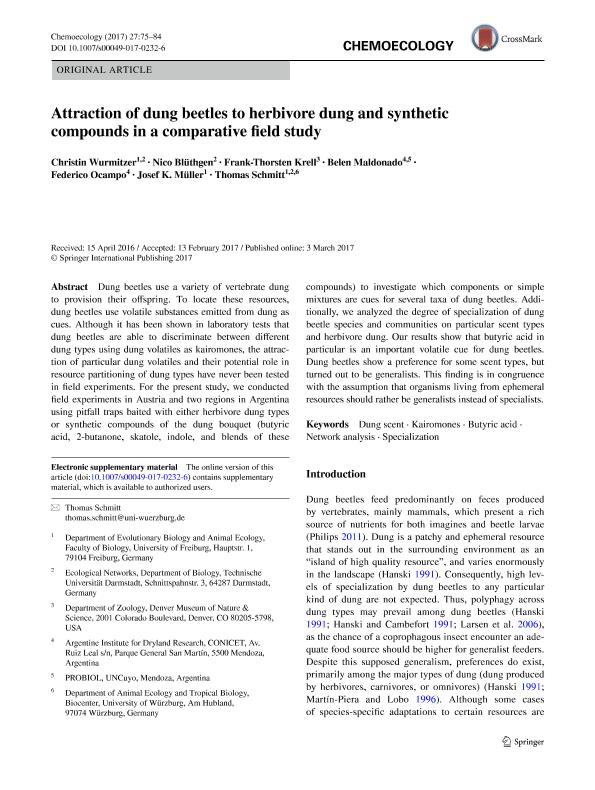Artículo
Attraction of dung beetles to herbivore dung and synthetic compounds in a comparative field study
Wurmitzer, Christin; Blüthgen, Nico; Krell, Frank Thorsten; Maldonado, María Belén ; Ocampo, Federico Carlos
; Ocampo, Federico Carlos ; Müller, Josef K.; Schmitt, Thomas
; Müller, Josef K.; Schmitt, Thomas
 ; Ocampo, Federico Carlos
; Ocampo, Federico Carlos ; Müller, Josef K.; Schmitt, Thomas
; Müller, Josef K.; Schmitt, Thomas
Fecha de publicación:
04/2017
Editorial:
Birkhauser Verlag Ag
Revista:
Chemoecology
ISSN:
0937-7409
Idioma:
Inglés
Tipo de recurso:
Artículo publicado
Clasificación temática:
Resumen
Dung beetles use a variety of vertebrate dung to provision their offspring. To locate these resources, dung beetles use volatile substances emitted from dung as cues. Although it has been shown in laboratory tests that dung beetles are able to discriminate between different dung types using dung volatiles as kairomones, the attraction of particular dung volatiles and their potential role in resource partitioning of dung types have never been tested in field experiments. For the present study, we conducted field experiments in Austria and two regions in Argentina using pitfall traps baited with either herbivore dung types or synthetic compounds of the dung bouquet (butyric acid, 2-butanone, skatole, indole, and blends of these compounds) to investigate which components or simple mixtures are cues for several taxa of dung beetles. Additionally, we analyzed the degree of specialization of dung beetle species and communities on particular scent types and herbivore dung. Our results show that butyric acid in particular is an important volatile cue for dung beetles. Dung beetles show a preference for some scent types, but turned out to be generalists. This finding is in congruence with the assumption that organisms living from ephemeral resources should rather be generalists instead of specialists.
Palabras clave:
Butyric Acid
,
Dung Scent
,
Kairomones
,
Network Analysis
,
Specialization
Archivos asociados
Licencia
Identificadores
Colecciones
Articulos(IADIZA)
Articulos de INST. ARG DE INVEST. DE LAS ZONAS ARIDAS
Articulos de INST. ARG DE INVEST. DE LAS ZONAS ARIDAS
Citación
Wurmitzer, Christin; Blüthgen, Nico; Krell, Frank Thorsten; Maldonado, María Belén; Ocampo, Federico Carlos; et al.; Attraction of dung beetles to herbivore dung and synthetic compounds in a comparative field study; Birkhauser Verlag Ag; Chemoecology; 27; 2; 4-2017; 75-84
Compartir
Altmétricas



